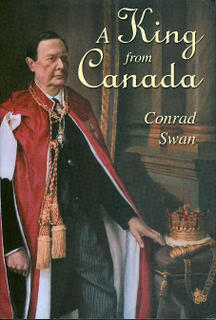A King From Canada
 Review: A King from Canada by Conrad Swan
Review: A King from Canada by Conrad Swan(Stanhope, Co. Durham: The Memoir Club, 2005. £18.50 ISBN: 1-84104-072-X)
It is difficult to overstate the richness of Sir Conrad Swan’s account of a remarkable life, from his childhood on Vancouver Island, British Columbia, to his appointment to what is arguably the most prestigious position in the heraldic world, Garter Principal King of Arms of the United Kingdom’s College of Arms. The book is at once a broadly sweeping narrative touching five continents and an intimate remembrance of Swan’s family life, comrades in the Indian Army of the British Empire, and many other friends and acquaintances.
The devotee of heraldry will certainly be fascinated by the detailed descriptions of the internal workings of the College of Arms, and by the authoritative outlines of the investiture ceremonies of several distinguished orders of the United Kingdom and the Commonwealth, including the Order of Canada, the Most Honourable Order of the Bath, the Most Distinguished Order of St. Michael and St. George, and, the most senior of the British orders, the Most Noble Order of the Garter. Also recounted are a number of significant state occasions occurring during Swan’s tenure in the College, from his appointment as Rouge Dragon Pursuivant of Arms in December 1962 to his succession to the title of Garter Principal King of Arms in 1992 and eventual retirement from that office in 1995. These events included State Openings of Parliament, the funeral of Sir Winston Churchill (1965), and the Investiture of the Prince of Wales (1969).
The book is not only a veritable treasure trove of heraldic insights, but also a moving historical account of the author’s ancestry. A detailed account of his father’s Polish-Lithuanian ancestry (the family name having been Swiecicki, changed by the author’s father to Swan) traces their origins and recognition as minor nobility of the Russian Empire in the early 19th century. His mother’s roots (Green) in Hertfordshire are also examined. These family histories are no mere lists of names and dates, but rather most effectively weave together the lives of Swan’s forebears with the historical and political threads that affected them.
Finally, it must be stated that the writing in A King From Canada is truly masterful. The finely-crafted prose is most readable, and yet polished and erudite. Phrases in foreign languages (often Latin) are employed often enough to add linguistic seasoning to the volume, but are not excessive or arbitrary in placement. A sense of gentility permeates the book, and the reader is effectively transported as a silent witness to the details of a life nobly lived, and service most capably rendered to the Crown.
A King From Canada is essential reading for those devoted to the study of heraldry, as it presents the ultimate insider’s perspective on the College of Arms. However, the diverse historical, genealogical, and social fabric of the work ensures that it will be thoroughly enjoyed by all those who appreciate the sweep of human events and the work of an author who wields the English language with authority, grace, and the occasional good-natured wink of an eye.
(Review for The Armiger's News, Fall 2005, the quarterly journal of The American College of Heraldry


0 Comments:
Post a Comment
<< Home